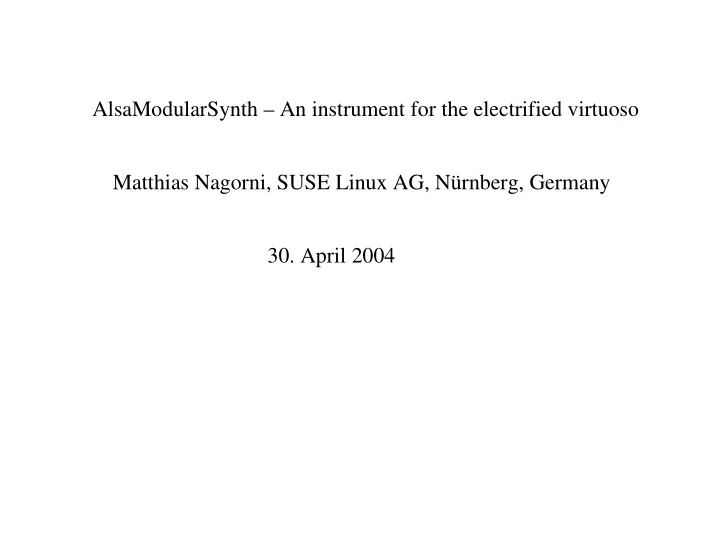

AlsaModularSynth – An instrument for the electrified virtuoso Matthias Nagorni, SUSE Linux AG, Nürnberg, Germany 30. April 2004
Surprisingly, it was already in the early days of electronic music that its most expressive exponent was invented: Around 1918 Lev S. Termen invented the instrument that bears his name. The Theremin is the only instrument that is played without touching it.
The player controls the pitch by varying the distance between his right hand and the vertical antenna. The loudness is shaped with the left hand moving before the horizontal antenna. This allows an incredible fine control over the instrument being as expressive as a violin.
However the Theremin is even more difficult to play than a string instrument. Therefore let's go back to the world of keyboard instruments. Also in this area some of the earlier designs allow a much more expressive playing than current commercial keyboards. Probably the most advanced example is the Sackbut synthesizer built in 1948 by Hugh Le Caine. Its keyboard did not not only feature velocity sensitivity but also pitch control. When a key was moved horizontally the respective pitch would change. While the player was assumed to play the notes with his right hand, the left hand was supposed to modify the timbre. For this there were pressure-sensitive controls for each finger (numbering as in piano scores): 1: Main Formant, Auxiliary Formant 2: Basic Waveform Control 3-5: Controls which produce departure from periodicity Recommentation: Go to www.hughlecaine.com and find out more...
Controls of such complexity are not available commercially. Anyway it's even more fun to design alternate controls oneself. The Linux operating system with its open source approach is ideally suited for building interfaces to alternate input devices. Frank Neumann has e.g. written a MIDI driver for a graphic tablet offering 5 independent parameters: Pos-X, Pos-Y, Pressure, Tilt-X, Tilt-Y. The modular synthesizer AlsaModularSynth is designed to offer a flexible interface to MIDI controllers. Any parameter of a patch can be bound to either MIDI controller or note events.
Here you see the main window of AlsaModularSynth with a three- oscillator patch typical for subtractive synthesis.
All MIDI Bindings are defined in the „AlsaModularSynth Control Center“. If the window is visible and receives MIDI Controller events, the respective controllers are listed in the left list. They can then be bound to the parameters listed below their respective module in the right list. In many cases only a limited range of a continuous parameter is used. Therefore the range to which the MIDI range of 0..127 is mapped can be freely chosen. For each continuous parameter a logarithmic mapping can be activated.
In addition to the complete parameter list in the „Control Center“, each module has its own configuration dialog. It is opened by right-clicking on the module name. Usually only a subset of these parameters is needed to control the sound charateristics of a given patch. Parameters can therefore be arranged into a „Parameter View“ dialog.
In the „Parameter View dialog“ the parameters are arranged in frames and tabs. For the parameters that are part of the „Parameter View“ it is possible to define presets. Pressing „Add Preset“ will save the current set of parameter values as a new preset. These presets can be accessed via MIDI Program Change events.
Moving a parameter into the „Parameter View“ dialog is done in the „Control Center“ by first selecting it and then pressing „Add to Parameter View“. It is possible to change the parameter name according to its function in a certain patch.
For expressive realtime control over the sound, it is possible to map the MIDI velocity CV to arbitrary functions. The „Function“ module offers a mapping of one input CV to up to 4 output CVs that are defined by stepwise linear functions. Each function can have up to 11 control points.
The most complex module of AlsaModularSynth is the „Dynamic Waves“ module. It features additive synthesis of up to 8 oscillators. Each oscillator is controlled by an eight-step envelope. As you can immediately see, this kind of synthesis is not suited for realtime sound modifications during live playing.
Subtractive synthesis is much better suited for realtime sound screwing because the amount of parameters that define a sound is much less than for additive synthesis. Fons Adriaensen has written high quality oscillator and filter plugins that can be loaded into AlsaModularSynth via the „Ladspa Browser“. Make sure you create them as „Poly Plugins“ to enable polyphonic playing.
AlsaModularSynth has „Scope“ and „Spectrum“ modules that can be used to show how subtractive synthesis works: The rich spectrum of a e.g. a sawtooth wave is shaped by a filter. The most famous of such filters is the lowpass invented by R.A. Moog around 1964. Its characteristics are mainly defined by only two parameters: cutoff frequency and resonance.
AlsaModularSynth can not only receive MIDI data but also send it. The „MIDI Out“ module can convert the internal control voltages of AlsaModularSynth into MIDI controller, pitchbend or note events. This way you can e.g. control your MIDI expander with a LFO of AlsaModularSynth.
And now its time for some sound samples...
Acknowledgement: Fons Adriaensen has provided many ideas (VC Double Decay envelope, Function module, speed optimization, etc.) and code to the AlsaModularSynth project. The high quality of his filter and oscillator plugins form the basis of the warm analogue sound of AlsaModularSynth.
Recommend
More recommend